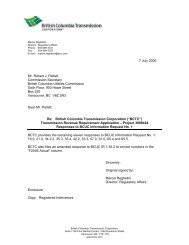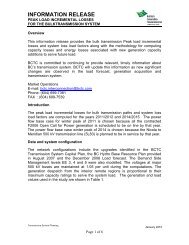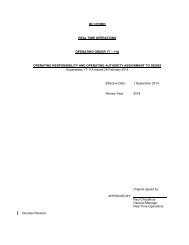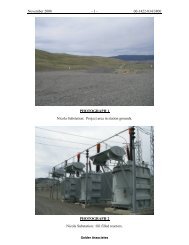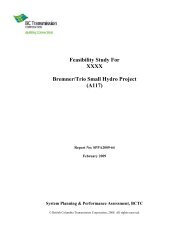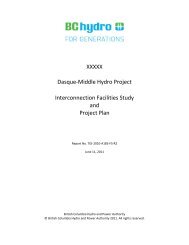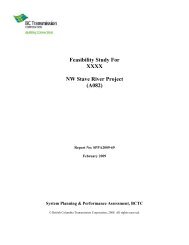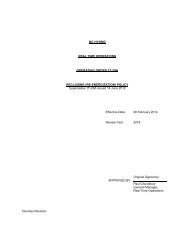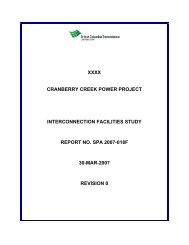Evidence on the Adequacy of First Nations Consultation - BC Hydro ...
Evidence on the Adequacy of First Nations Consultation - BC Hydro ...
Evidence on the Adequacy of First Nations Consultation - BC Hydro ...
Create successful ePaper yourself
Turn your PDF publications into a flip-book with our unique Google optimized e-Paper software.
4. THE GEOGRAPHY OF THE EAST KOOTENAYS<br />
As this study will make reference to numerous locati<strong>on</strong>s and <strong>the</strong>ir inter-relating roles in <strong>the</strong> traditi<strong>on</strong>al<br />
and more recent Ktunaxa modes <strong>of</strong> life, a descripti<strong>on</strong> <strong>of</strong> major aspects <strong>of</strong> <strong>the</strong> regi<strong>on</strong>’s geography is<br />
useful. The territory <strong>of</strong> <strong>the</strong> Ktunaxa features dramatic and formative geological features, most<br />
notably three high north-south mountain ranges - <strong>the</strong> Rockies, Purcells and Selkirks – and two major<br />
river systems, <strong>the</strong> Columbia and <strong>the</strong> Kootenay. An interesting feature <strong>of</strong> <strong>the</strong> territory is that <strong>the</strong>se two<br />
great rivers rise within a few miles <strong>of</strong> each o<strong>the</strong>r, and form opposing arcs <strong>of</strong> hundreds <strong>of</strong> miles in<br />
length before joining near <strong>the</strong> town <strong>of</strong> Castlegar and flowing south through Washingt<strong>on</strong> State.<br />
O<strong>the</strong>r crucial elements <strong>of</strong> <strong>the</strong> ec<strong>on</strong>omic geography <strong>of</strong> <strong>the</strong> regi<strong>on</strong> are <strong>the</strong> many mountain passes, which<br />
traditi<strong>on</strong>ally provided <strong>the</strong> Ktunaxa people access to both upland game and material resources bey<strong>on</strong>d<br />
<strong>the</strong>se mountains, most notably <strong>the</strong> bis<strong>on</strong> <strong>of</strong> <strong>the</strong> western plains and fish in <strong>the</strong> West Kootenay regi<strong>on</strong>.<br />
Some <strong>of</strong> <strong>the</strong>se passes are now used as routes for major rail and road links.<br />
These features naturally give rise to a great diversity <strong>of</strong> biogeoclimatic z<strong>on</strong>es, ranging from damp<br />
timberlands to xeric grasslands to alpine tundra and c<strong>on</strong>sequently a wide range <strong>of</strong> adaptati<strong>on</strong>s in<br />
resource utilizati<strong>on</strong> which include <strong>the</strong> broad array <strong>of</strong> mammals, fish, birds, plants and invertebrates<br />
(e.g. molluscs) that have sustained <strong>the</strong> Ktunaxa and <strong>the</strong>ir ancestors for millennia.<br />
The highest abundance and diversity <strong>of</strong> wildlife species within <strong>the</strong> Nels<strong>on</strong> Forest Regi<strong>on</strong> occurs in <strong>the</strong><br />
East Kootenay. This are is unique in its capacity to support seven species <strong>of</strong> ungulates, many <strong>of</strong> which<br />
inhabit <strong>the</strong> same winter ranges. This diversity, couple with <strong>the</strong> capacity to support several species <strong>of</strong><br />
carnivores, makes <strong>the</strong> East Kootenay a wildlife area <strong>of</strong> nati<strong>on</strong>al significance. 4<br />
A breakdown <strong>of</strong> this diversity indicating that <strong>the</strong> study area has <strong>the</strong> best wildlife values in <strong>the</strong> regi<strong>on</strong><br />
has been tabulated by Pinnell in a 1998 report <strong>on</strong> <strong>the</strong> impact <strong>of</strong> forestry and titled “Background<br />
Informati<strong>on</strong> for Kootenay-Boundary Regi<strong>on</strong>” 5<br />
Sou<strong>the</strong>rn Park Ranges<br />
Locati<strong>on</strong>: Rocky Mountains including Bull River and Blaeberry River<br />
Terrain: Rugged mountains, l<strong>on</strong>g rivers and narrow valleys, 1100 to 3500m<br />
Rainshadow area, cool and dry<br />
Wildlife: Moose, elk, white-tailed deer, grizzly and black bear, mule deer in valley bottoms<br />
Bighorn sheep, mule deer, elk, mountain goats at higher elevati<strong>on</strong>s<br />
Central Park Ranges<br />
Locati<strong>on</strong>: Rocky Mountains from Blaeberry in <strong>the</strong> south to Hugh Allen Creek<br />
Terrain: High, rugged mountains with glaciers, short steep sided mountains<br />
600 to 3300 m<br />
Wildlife: Floodplains, riparian and avalanche tracks provide habitat for moose, elk, grizzly,<br />
black bear, beaver, wolf<br />
Caribou populati<strong>on</strong> reduced due to flooding <strong>of</strong> Columbia<br />
Big Bend Trench<br />
Locati<strong>on</strong>: Northwest <strong>of</strong> D<strong>on</strong>ald Stati<strong>on</strong><br />
Terrain: Narrow straight valley with steep sides; 680 to 1100m<br />
4 Demarchi, D.A., 1986, from Braumandl, T.F., and Curran, M.P , p. 201, 2002<br />
5 Pinnell, Hea<strong>the</strong>r; pp. 21, 22, 1998<br />
4<br />
Page 148 <strong>of</strong> 200






